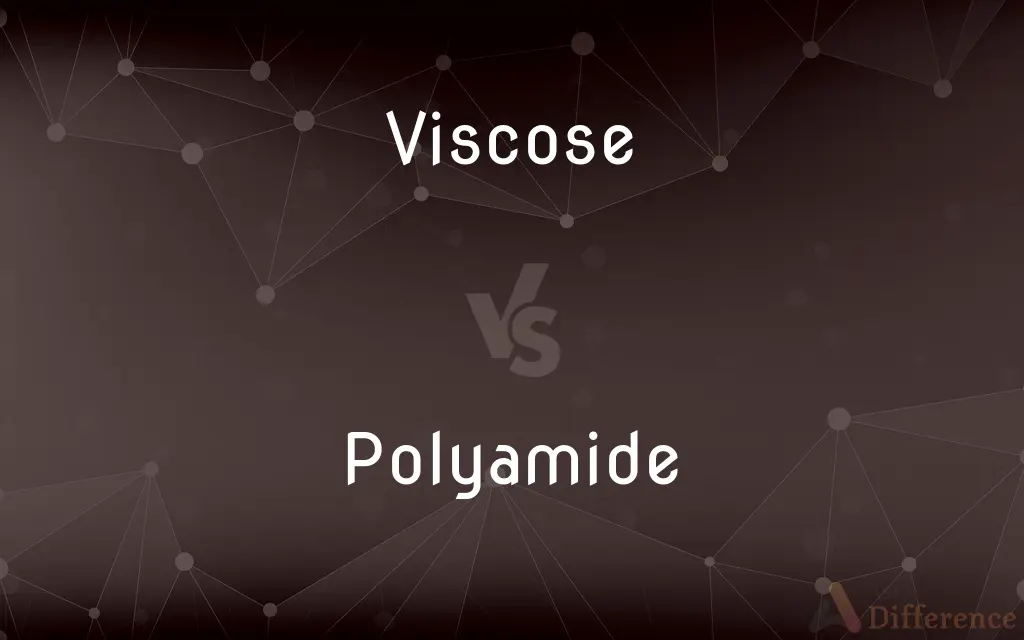Viscose vs. Polyamide — What's the Difference?
By Urooj Arif & Fiza Rafique — Updated on April 17, 2024
Viscose is a semi-synthetic fiber made from cellulose, known for its silk-like feel and breathability, while polyamide, a synthetic polymer, is recognized for its durability and resistance to wear.

Difference Between Viscose and Polyamide
Table of Contents
ADVERTISEMENT
Key Differences
Viscose, derived from natural cellulose, is celebrated for its softness and excellent drape, making it a popular choice in flowy dresses and blouses. Conversely, polyamide, often known as nylon, is engineered for strength and elasticity, ideal for activewear and outdoor gear.
The manufacturing process of viscose involves dissolving cellulose in chemicals and spinning it to form fibers, emphasizing sustainability challenges due to chemical use. On the other hand, polyamide is produced by polymerizing specific molecules, resulting in a fiber that can be more consistently controlled for strength and texture.
Viscose tends to absorb moisture well, making it comfortable to wear in warm weather but prone to wrinkling and shrinkage. Polyamide, however, is highly resistant to moisture and abrasion, making it easier to maintain and more durable under strenuous conditions.
Environmental impact is a significant consideration; viscose's production can be pollutant-heavy, though it biodegrades more quickly. Polyamide's durability contributes to longevity but it is derived from petrochemicals and is less biodegradable, impacting long-term sustainability.
In terms of care, viscose often requires delicate handling, preferably hand washing or dry cleaning, to avoid damage during laundry. Polyamide is generally machine washable and resistant to damage from washing, providing a low-maintenance option for everyday use.
ADVERTISEMENT
Comparison Chart
Source Material
Cellulose (natural)
Petrochemicals (synthetic)
Durability
Less durable, prone to wear
Highly durable, abrasion-resistant
Moisture Management
High moisture absorption
Moisture resistant
Environmental Impact
Pollutant-heavy production; biodegradable
Less biodegradable; petrochemical-based
Care Instructions
Delicate handling required
Easy care, machine washable
Compare with Definitions
Viscose
Absorbs moisture, making it cool to wear.
Viscose garments are preferred in summer due to their breathability.
Polyamide
Synthetic fiber, also known as nylon.
The polyamide jacket proved to be water-resistant during the hike.
Viscose
Requires gentle care, often hand washing.
Always check the label, as viscose clothing may need to be hand washed.
Polyamide
Characterized by its strength and durability.
Polyamide fabrics are commonly used in sports apparel.
Viscose
Known for its silky feel and sheen.
Viscose fabric is often used for party wear because of its glossy appearance.
Polyamide
Easy to care for, usually machine washable.
The best thing about polyamide curtains is their ease of maintenance.
Viscose
Can be environmentally taxing to produce.
The production of viscose is criticized for its environmental impact.
Polyamide
Derived from petrochemicals, raising sustainability concerns.
Polyamide is durable but its synthetic origin is less eco-friendly.
Viscose
A semi-synthetic fiber made from regenerated cellulose.
The dress made of viscose draped beautifully but required careful washing.
Polyamide
Resists moisture and dries quickly.
Polyamide socks are ideal for long treks because they keep feet dry.
Viscose
A thick, golden-brown viscous solution of cellulose xanthate, used in the manufacture of rayon and cellophane.
Polyamide
A polyamide is a polymer with repeating units linked by amide bonds.Polyamides occur both naturally and artificially. Examples of naturally occurring polyamides are proteins, such as wool and silk.
Viscose
Viscose rayon.
Polyamide
A synthetic polymer of a type made by the linkage of an amino group of one molecule and a carboxylic acid group of another, including many synthetic fibres such as nylon.
Viscose
Viscous.
Polyamide
A polymer containing repeated amide groups, as in various kinds of nylon.
Viscose
Of, relating to, or made from viscose.
Polyamide
(chemistry) Any of a range of polymers containing amide (or peptide) repeat units; examples include proteins and nylon.
Viscose
A viscous orange-brown liquid obtained by chemical treatment of cellulose and used as the basis of manufacturing rayon and cellulose film.
Polyamide
A polymer containing repeated amide groups
Viscose
A fabric made from this material.
Viscose
A cellulose ester obtained by treating cellulose with caustic soda
Viscose
A rayon fabric made from viscose (cellulose xanthate) fibers
Common Curiosities
What are the main uses of polyamide?
Polyamide is primarily used in activewear, outdoor equipment, and hosiery for its durability and elasticity.
How does viscose impact the environment?
Viscose production can be pollutant-heavy, though it is biodegradable.
Can viscose fabrics be washed in a washing machine?
Viscose is generally recommended to be hand washed or dry cleaned to avoid shrinkage and maintain its integrity.
How is polyamide manufactured?
Polyamide is produced through a chemical polymerization process involving monomers like adipic acid and hexamethylene diamine.
Why is polyamide considered durable?
Polyamide fibers are engineered for high tensile strength and abrasion resistance, making them last longer under stress.
Is polyamide environmentally friendly?
Polyamide is less biodegradable and made from non-renewable petrochemicals, presenting environmental challenges.
Does viscose shrink after washing?
Yes, viscose can shrink and lose shape if not washed according to the care instructions.
Is viscose a good choice for summer clothing?
Yes, due to its moisture-absorbing properties, viscose is a comfortable choice for warm weather.
What is viscose typically used for?
Viscose is often used in fashion for making blouses, dresses, and linings due to its soft texture and sheen.
What are the care instructions for polyamide fabrics?
Polyamide fabrics are typically machine washable and very resilient to laundry processes.
Share Your Discovery

Previous Comparison
Daring vs. Courage
Next Comparison
Showcase vs. ShowtimeAuthor Spotlight
Written by
Urooj ArifUrooj is a skilled content writer at Ask Difference, known for her exceptional ability to simplify complex topics into engaging and informative content. With a passion for research and a flair for clear, concise writing, she consistently delivers articles that resonate with our diverse audience.
Co-written by
Fiza RafiqueFiza Rafique is a skilled content writer at AskDifference.com, where she meticulously refines and enhances written pieces. Drawing from her vast editorial expertise, Fiza ensures clarity, accuracy, and precision in every article. Passionate about language, she continually seeks to elevate the quality of content for readers worldwide.
















































